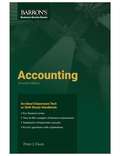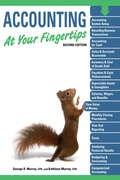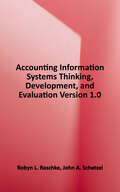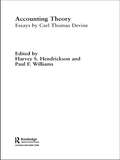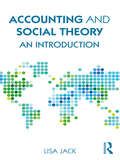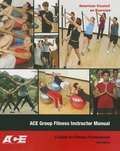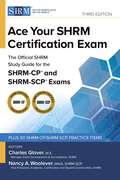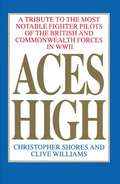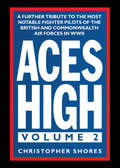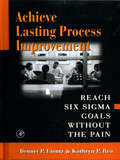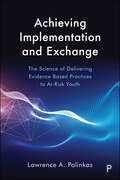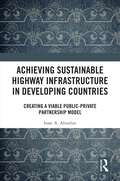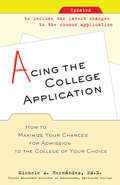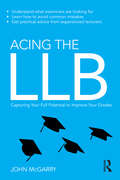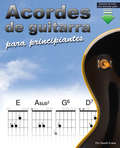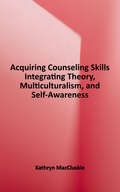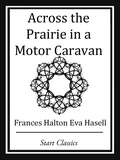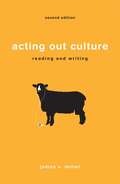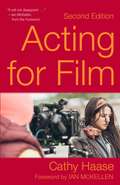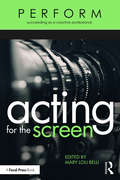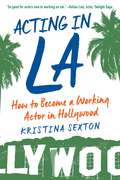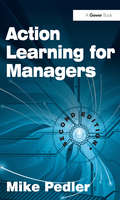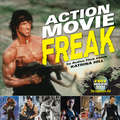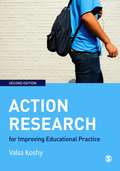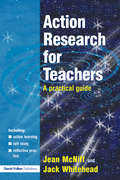- Table View
- List View
Accounting (Barron's Business Review)
by Peter J. EisenLike the other titles in Barron&’s Business Review Series, this Seventh edition of Accounting makes a useful supplement to college textbooks, and is also excellent as a main text in business brush-up programs. Author Peter J. Eisen familiarizes students with key accounting terms, explains the accounting equation, and goes on to instruct in the use and preparation of financial statements, the recording of business transactions in journals, and in closing and adjusting entries at the end of a business period. The book is organized to closely follow a standard college textbook, but concentrates on student understanding of what is done, and, more importantly, how and why. Other helpful features include: Review questions Computational problems with complete detailed solutions presented when appropriate Additional problems to reinforce the reader&’s knowledge An extensive glossary of accounting terms. This edition includes instruction in the use of spreadsheets to solve many accounting problems, a more detailed explanation of accounting data procedures as internal controls designed to safeguard assets, and extensive commentary on business ethics.
Accounting At Your Fingertips, 2e (At Your Fingertips)
by George R. MurrayMost small business owners learn early on that it's much cheaper to do their own books (alone or with the assistance of a bookkeeper or accounting clerk) and have them reviewed by an accountant than to have a CPA on staff. With a steady supply of entrepreneurs opening new businesses, there's a real need for a one-stop accounting reference busy owners, bookkeepers, and accounting clerks can use to access the specific information they need quickly and accurately. Accounting at Your Fingertips, Second Edition, helps readers pinpoint the precise information they need on any accounting topic without wasting time. Divided into concise but complete bites that are easy to find and easy to understand, Accounting at Your Fingertips, Second Edition, covers all topics related to the monthly accounting process. Based on the notion that time is the scarcest commodity of all, this book is organized to allow readers the shortest path to the information they need, including: Organization and proper accounting procedures. Creating a chart of accounts and balance sheet accounts. Posting accounts to the general ledger. Reporting assets and expenses. Handling receivables, payroll, and cost of goods and services. Posting salaries, wages, and payroll taxes. End-of-month accounting tasks and procedures. Producing balance sheets, profit and loss statements, and end-of-year payroll reports. Closing the books at the end of the year.
Accounting Information Systems: Thinking, Development, and Evaluation Version 1.0
by Robyn L. Raschke John A. SchatzelThis book's key goal is to provide students with a basic understanding of AIS terminology and topics in an approachable way. As a result, the writing style is intentionally crafted to be easy to understand for students who are new to accounting information and related decision-making responsibilities. Further, there is a strong focus throughout on emerging accounting technologies such as distributive ledgers including blockchain, smart contracts, robotic process automation, machine learning, and artificial intelligence (AI). Including these topics in more meaningful ways exposes students to new technologies’ impacts on accounting. Further, such coverage encourages them to develop an inquisitive and flexible mindset based on the premise that an AIS is not static. As a result, students learn an AIS must be continuously assessed and re-evaluated in order to keep pace with constant organizational change, the introduction of new technologies, and an ever-evolving regulatory environment. Finally, the narrative is consistently organized around three key perspectives: the user, design, and control. These three organizing themes support and guide the learner's journey through understanding how accountants use information to make decisions, how an AIS works, and how to recognize and minimize the threats to an AIS.
Accounting Theory: Essays by Carl Thomas Devine (New Works In Accounting History Ser.)
by Harvey S. Hendrickson Paul F. WilliamsOne of the outstanding accounting theoreticians of the twentieth century, Carl Thomas Devine exhibited a breadth and depth of knowledge few in the field of accounting have equalled. This book collects together eight previously unpublished essays on accounting theory written by Professor Devine.Professor Devine passed away in 1998, prior to the sign
Accounting and Social Theory: An introduction
by Lisa JackIs society possible without accounting? In speech or in writing, we communicate actions, plans and decisions using numbers, calculations, words and images. Although accounting research is dominated by quantitative analyses, the role of accounting in society is firmly established over thousands of years. In this concise book, Lisa Jack demonstrates the power of social theory in expanding the value of accounting research. Accounting and Social Theory: An introduction includes advice on research problems as well as guidance on fertile areas for new research. The tools, techniques and developments covered by the author help readers to see social research in accounting as the study of the use, misuse and abuse of accounting communications by people and the effects that this has on social relationships. Stories of accounting in war, agriculture and food, gender, health and other areas illustrate the ways in which the threads of accounting run through society. Having emerged from the author’s wealth of teaching experience, this book provides a student-focused treasure trove that illuminates the field for early-career researchers in accounting and established academics looking to expand the impact of their work.
Ace Group Fitness Instructor Manual: A Guide for Fitness Professional
by AceThe all-new ACE Group Fitness Instructor Manual, 3rd Edition, prepares fitness professionals to design effective group fitness programs and both safely and successfully lead a wide range of class formats and participants. A must-have resource for group fitness instructors, the manual addresses critical core competencies regardless of the types of classes you plan to teach. Topics range from instruction techniques and program design to the business of group fitness and an instructor's ethical and legal responsibilities as well. Additionally, the manual tackles important considerations that group fitness instructors face when instructing a variety of individuals, including pregnant women and those with significant weight challenges. The manual includes an all-new companion DVD, Essentials of Group Fitness Instruction, on which world-renowned group fitness expert and award-winning presenter, Lawrence Biscontini, offers essential steps and strategies to unlocking the critical elements of group fitness. Discover key components of class design, such as how to determine desired outcomes through exercise and movement selection, sequencing, choreography, program modifications and music.
Ace Your SHRM Certification Exam: The OFFICIAL SHRM Study Guide for the SHRM-CP® and SHRM-SCP® Exams
by Charles Glover and Nancy A. Woolever, editorsPreparing for the SHRM-CP® and SHRM-SCP® certification exams can be daunting-but it doesn't have to be, if you have the official SHRM study guide. This concise, accessible guide helps HR professionals understand the structure of both exams and equips them with the tools to succeed. With 50 original practice questions, expert test-taking strategies, tips for managing anxiety and research-based study techniques, this resource is designed to build confidence and sharpen performance. It also includes glossaries of key terms and acronyms, practical advice from test-takers and curated study resources to guide your prep from start to finish.Whether you're just beginning or nearing test day, this guide offers everything you need to prepare with purpose and pass with confidence.
Aces High, Volume 1: A Tribute to the Most Notable Fighter Pilots of the British and Commonwealth Forces of WWII
by Christopher Shores Clive WilliamsFirst in the Aces High series—a military reference of the fighter pilots who had five or more confirmed victories while serving in the Royal Air Force. Introduced by the French quite early in World War I, the term &“ace&” was used to describe a pilot credited with five or more aerial victories. But in the United Kingdom, the term was never officially recognized. Becoming an ace was partly luck, especially considering the campaigns in which they flew and the areas of combat. There are three distinct kinds of aces: the defensive ace, the offensive ace, and the night fighter. This book is a revised collection of the biographies of the highest scoring Allied fighter pilots of World War II—including those with the confirmed claims of shooting down five aircraft and those pilots with lower scores but whose wartime careers prove them worthy of inclusion. All details of their combat are arranged in tabular form. Included are a selection of photographs from hitherto private collections. &“There are some authors whose name alone is sufficient reason to but a book, and Christopher Shores is surely one of these . . . By profession a chartered surveyor, he served in the Royal Air Force in the 1950s so his writing bears the stamp of authenticity.&” —HistoryNet
Aces High, Volume 2: A Further Tribute to the Most Notable Fighter Pilots of the British and Commonwealth Air Forces in WWII
by Christopher ShoresSecond in the Aces High series—an updated military reference of the fighter pilots who had five or more confirmed victories while serving in the RAF. This volume updates the information in the first volume and adds some new names. Information has been added on the pilots who gained success against the V-1 flying bombs during 1944-45. Detail is also provided on those units in which virtually all the fighter pilots served at some time or another—the fighter Operational Training Units—and of specialist units such as the Central Gunnery School, Fighter Leader&’s School and Fighter Experimental Units. There is also coverage of the only other conflicts in which British pilots have been able to claim victories since 1945—Korea and the Falklands Conflict. &“There are some authors whose name alone is sufficient reason to but a book, and Christopher Shores is surely one of these . . . By profession a chartered surveyor, he served in the Royal Air Force in the 1950s so his writing bears the stamp of authenticity.&” —HistoryNet
Achieve Lasting Process Improvement
by Bennet Lientz Kathryn ReaMethods of improving business processes are developed on an ongoing basis, but few are successful. Common problems encountered include the failure of processes to meet expectations and the inability to sustain or replicate these business processes. Involvement of personnel at grassroots level, as well as at management level, is essential in implementing effective process improvement methods. The authors present a step-by-step approach to the issue of effective process improvement, offering more than 200 tips and guidelines as well as addressing specific common problems and issues. The strategy presented is to take a broad and intuitive, but learned view of process improvement methods, and the tactics expounded are based on guidelines, common faults, and lessons learned. The authors disparage process improvement operations that depend on jargon and the support of just upper management, and promote grassroots involvement and self-sustaining measurement, making this an essential guide for all with involvement in process improvement.
Achieving Implementation and Exchange: The Science of Delivering Evidence-Based Practices to At-Risk Youth
by Lawrence A. PalinkasConverting research evidence into practice is an issue of growing importance to many fields of policy and practice worldwide. This book, by a leading implementation specialist in child welfare and mental health, addresses the frustrating gap between research conducted on effective practices and the lack of routine use of such practices. Drawing on implementation science, the author introduces a model for reducing the gap between research and practice. This model highlights the roles of social networks, research evidence, practitioner/policymaker decision-making, research-practice-policy partnerships, and cultural exchanges between researchers and practitioners and policymakers. He concludes with a discussion of how the model may be used to develop more widespread use of evidence-based practices for the prevention and treatment of behavioural and mental health problems in youth-serving systems of care, as well as partnerships that promote ongoing quality improvement in services delivery.
Achieving Sustainable Highway Infrastructure in Developing Countries: Creating a Viable Public-Private Partnership Model
by Isaac AbiodunThis book investigates the challenges being experienced in the traditional procurement methods for road infrastructure in developing countries and explores the features of Public Private Partnerships (PPP) as an alternative procurement method with the potential of achieving a more sustainable highway network in Nigeria and other developing countries of Africa.The book starts with an investigation into the challenges of traditional Design Bid Build (DBB) procurement methods before examining the features of PPP and its potentials as an alternative procurement method for highway development, operation and maintenance, including developing and validating a PPP framework and model for application in the sustainable development and construction of highways. The PPP model developed from the study is expected to enhance decision making in the choice between the DBB and PPP methods during project planning and procurement stages. The author has developed a simple framework, illustrated in a single pictorial display the interconnected relationships, the performances of both the procurement methods, and the possible enhancement of the DBB method and the implementation procedure of the PPP method for sustainable highway infrastructure in developing countries.The framework developed and explained in this book will be of benefit to infrastructure leaders and policy makers, regulators, operators, maintenance agencies and contractors in developing countries and researchers and academics studying infrastructure procurement and delivery methods.
Acing the College Application: How to Maximize Your Chances for Admission to the College of Your Choice
by Michele HernandezWith so many qualified applicants, competition for college admissions is fiercer than ever. Now you can put yourself ahead of the pack by making your application flawless!When applying for college, good grades and high standardized test scores are not always enough to guarantee admission. What sets you apart, argues Michele Hernández, is the way you describe yourself in your application. But how do you present yourself with flair, and highlight all your talents, skills, and passions, in just a few pages?A former assistant director of admissions at Dartmouth College, Dr. Hernández takes you step-by-step through the entire application process, revealing the details that make or break an applicant. From the multitude of short and longer essays to the myriad of charts, lists, and personal data sections, she offers essential advice, useful anecdotes, and vivid examples. Included are:• A line-by-line look at the common application• The truth about the essays, with samples of those that made the grade • The best way to ask for teacher and guidance counselor recommendations• When to provide colleges with optional essays and peer evaluations• The ten common myths and misconceptions of the on-campus interview• The most meaningful academic subjects, work experience, and extracurricular activities to mention• Early action versus early decision—the trade offsWith this helpful, savvy book, prospective college students—and their parents and counselors—can now vastly improve their chances of getting into the college of their choice. “Want to scale the Ivy wall? Michele Hernández gives you the tools to do it. This brisk, no-nonsense book is built on inside dope, and Hernández’s experience allows her to challenge conventional admissions thinking.”—HARRY BAULD Author of On Writing the College Application Essay
Acing the LLB: Capturing Your Full Potential to Improve Your Grades
by John McGarryOften law students don't achieve the results they are capable of, not because of a lack of intellectual ability, but because they haven’t fully understood what is required of them and what they could and should do to achieve higher marks. Acing the LLB will help those students realise their full potential and achieve the very best marks. It explains what lecturers are looking for in a top class answer and is packed with easy-to-follow practical advice that students can use to improve their performance. The author draws upon his own experiences as a lecturer and marker of student work as well as those of colleagues at a range of institutions to offer sound and realistic advice. Engaging, accessible and very readable, this is an ideal guide for anyone starting out on an LLB or for current law students who are looking to improve their grades.
Acordes de guitarra para principiantes: Un libro de acordes de guitarra para principiantes con acordes abiertos y más
by Gareth Evans"Es un libro muy completo que contiene acordes de las etapas iniciales y posteriores. Todo está muy bien explicado. Se lo recomiendo a cualquiera que esté empezando con la guitarra". Nigel Elliott, Guitarrista y Tutor (Irlanda del Norte) Acordes de guitarra para principiantes contiene 65 acordes diferentes arreglados en digitaciones fáciles. - Technique La técnica de la mano del diapasón para tocar los acordes de la guitarra se analiza en detalle con diagramas. Cuando es necesario, algunos acordes se enseñan de forma gradual porque hacer sólo los aspectos más difíciles de la digitación de un acorde primero, permite que la mano sea más libre de ajustarse. Otros acordes se muestran con diferentes digitaciones para que puedas elegir el que prefieras. Tocar los acordes de guitarra puede parecer una contorsión para las manos del principiante, por eso hay una guía básica sobre cómo estirarlas para mantener las manos flexibles. - Audio y más Cada acorde de guitarra tiene un ejemplo de audio descargable que te permite escuchar si lo has tocado bien, o escuchar lo que necesitas mejorar. Hay una introducción a los acordes de potencia y a los acordes de cejilla, en los que los acordes de cejilla se muestran como versiones más sencillas de las formas de los acordes de cejilla completa. En la parte posterior de Acordes de guitarra para principiantes hay una lista de canciones sugeridas que contienen acordes del libro. ¡Consigue tu copia hoy! "Se ve muy bien. Me gustan especialmente las diferentes formas de tocar el acorde de A. Los ejercicios de calentamiento para la flexibilidad también son buenos. Es bueno que los acordes de cejilla se muestren como versiones parciales para hacerlos inicialmente más fáciles, y los principiantes pueden encontrar más aspectos interesantes cerca de la parte posterior del libro, donde se muestran versiones abiertas fáciles de otros acordes más exóticos, como Dm(maj7), el acorde de "James Bond"". Campbell Murray, RGT & MU Tutor Registrado (Escocia)
Acquiring Counseling Skills: Integrating Theory, Multiculturalism, and Self-Awareness
by Kathryn MacCluskieThis is the first and only book in the market that provides a theoretical framework for basic counseling skills. There is a strong multicultural thread woven throughout the book, as well as a strong emphasis on self-awareness. Key Topics: the counseling process, the microskills model and helping skills and techniques, integrated case conceptualization Market: Written for students, counselors, social workers, psychologists, and anyone interested in learning the basic techniques of helping in the context of theory and application to diverse populations.
Across the Prairie in a Motor Caravan
by Reformed PresbyteryExcerpt The diocese of Qu'Appelle, in the province of Saskatchewan, Western Canada, is so named from the Indian story which tells of the maiden who lay dying, calling piteously for her lover. He, far off in his canoe on the Saskatchewan River, suddenly heard a voice, and answered: "Qu'Appelle." The voice came again, and then he knew it for that of his beloved, and made all speed to her side. But, alas! when he reached her she was dead. Qu'Appelle is a suggestive title and indicative of the call which so many have heard from the prairie provinces, a twofold call, urging some to earthly and some to spiritual husbandry. Some account of the Western Canada of to-day may be useful here.
Acting Out Culture: Reading and Writing (Second Edition)
by James S. MillerStudents are bombarded every day with media messages laden with rules: what makes our work valuable, our bodies ideal, our communities picture perfect. Acting Out Culture empowers students to use writing to speak back to their culture and question its rules. Featuring fresh readings by writers who lay bare and challenge the rules we live by, the second edition of Acting Out Culture gives students the tools they need to analyze and write critically about assumptions at the heart of cultural norms.
Acting for Film (Second Edition)
by Cathy Haase Ian McKellen"It will not disappoint . . ." —Ian McKellen, from the ForewordAn Authoritative Training Manual for Film Actors and Teachers “In today's entertainment industry of buff bodies and beautiful faces, it's easy to think that a couple of sit-ups and high cheek bones can create a movie legend,” writes film veteran Cathy Haase. However, she adds, what the actor really must have are “technique, craft, and a depth of self-knowledge.” In Acting for Film, Second Edition, Haase shows actors how to develop all of these, sharing her secrets (developed through years of on-camera work) for creating characters who come alive and who touch the souls of the audience. Readers will learn how to apply theatrical training to film acting and hone a personal approach to rendering a character. Acting for Film, Second Edition, is an essential guide for aspiring performers, acting teachers, and anyone interested in gaining a greater understanding of the craft. This new edition includes: Advice on dealing with new technology including CGI and motion capture Concentration and relaxation exercises that will enhance facial expressiveness Exploration of sense memory techniques for on-camera work Animal exercises and their usages Tips for maintaining proper eye focus in front of the camera and conveying the “beats” of a scene, even in the shortest takes For any performer who intends to make a living in front of the camera, Acting for Film, Second Edition, is the most authoritative resource! With Haase’s experience and advice in their pocket, readers will be prepared to land the film role they’ve been dreaming of.
Acting for the Screen (PERFORM)
by Mary Lou BelliActing for the Screen is a collection of essays written by and interviews with working actors, producers, directors, casting directors, and acting professors, exploring the business side of screen acting. In this book, over thirty show business professionals dispel myths about the industry and provide practical advice on topics such as how to break into the field, how to develop, nurture, and navigate business relationships, and how to do creative work under pressure. Readers will also learn about the entrepreneurial expectations in relation to the internet and social media, strategies for contending with the emotional highs and lows of acting, and money management while pursuing acting as a profession. Written for undergraduates and graduates studying Acting for Screen, aspiring professional actors, and working actors looking to reinvent themselves, Acting for the Screen provides readers with a wealth of first-hand information that will help them create their own opportunities and pursue a career in show business.
Acting in LA: How to Become a Working Actor in Hollywood
by Kristina SextonEach year, hundreds of aspiring and experienced actors head to LA hoping to make it big in Hollywood. While many of them have their acting chops in shape, few realize what it actually takes to survive in Tinseltown. Even if they happen to make it onto a set, many are clueless about what’s expected of them and how they should behave. Acting in LA: How to Become a Working Actor in Hollywood is exactly what these actors need: a handbook to arriving, surviving, and thriving on- and off-set in LA. Written by veteran Hollywood actor, acting coach, and acting teacher Kristina Sexton, this comprehensive guide takes no prisoners. With just enough snark to keep readers entertained—and on their toes—Acting in LA delivers solid advice on such topics as:Headshots, resumes, and reelsHow to find your “image” and market itThe SAG/AFTRA debateNetworkingAgents and managersThe importance of creating your own opportunitiesMaintaining a life outside of actingSetiquetteOn-set terminologyAnd much more A comprehensive guide that can be utilized by actors either inside or outside Hollywood, Acting in LA relies on Kristina’s real-life experience as a working actress and exposes the pleasures, pitfalls, and practicalities of pursuing a career in acting.
Action Learning for Managers: Second Edition
by Mike PedlerAction Learning for Managers is a clear, concise and straightforward guide to this well-established approach to problem solving and learning in groups that enables change in individuals, teams, organisations and systems. Through action learning people develop themselves and build the relationships that are the key to improving operations and bringing about innovations. With questionnaires, checklists, examples and practical advice, this little book includes everything you need to get started. Action learning is essentially a simple idea but one that requires thought, commitment and care to put into practice.
Action Movie Freak
by Katrina HillWritten by woman of action Katrina "Action Flick Chick" Hill, Action Movie Freak is packed with spine-tingling excitement and thrilling moments that make action movies a beloved genre for those who crave crashing cars, exploding buildings, and faces getting kicked six ways to Sunday. With badass heroes that ain't got time to bleed, women warriors, thrilling chases and outrageous fisticuffs, Action Movie Freak celebrates a wide variety of more than 100 movies that have left audiences on the edge of their seats. Complete movie reviews are divided into various sub-genres including Classics That Defined the Genre (The Bond movies of the 1960s, "Bullit," "Dirty Harry") Bloodiest Action Movies ("Ninja Assassin," "Rambo" series, "RoboCop") and Action From the Far East ("Bangkok Knockout," "Ong Bak," "Ip Man"). The book also spotlights specific action heroes/actors, and features 250 color photos and movie posters, as well as fun Top 10 lists, including best one-liners and most over-the-top kills.
Action Research for Improving Educational Practice: A Step-by-Step Guide
by Valsa KoshyWhich topics are right for Action Research in an education context? How do you go about planning a project, collecting and analysing your data? What's the best way to present your research findings to parents, colleagues or funding bodies? Whether you are a busy teacher doing research in your classroom, an undergraduate starting your research project, or a Masters level or education doctorate student writing up your dissertation, this step-by-step guide takes you through every stage involved in carrying out Action Research. In this brand new edition, you will find additional guidance on: - philosophical underpinnings of Action Research - the challenges of being an insider researcher - searching and analysing literature from the internet - children's participation and children's rights in action research projects in educational settings - validity and authenticity in action research - a new chapter on writing for publication - an action research planning sheet. This book draws on Valsa Koshy's extensive experience of supervising researchers at all levels, and includes examples of Action Research carried out by practitioners across a range of topics and age groups. Case studies include UK and international examples, allowing you to reflect on multiple perspectives of Action Research in education. Those new to Action Research, and those looking for a straightforward explanation of the methods involved, will find this book invaluable. Valsa Koshy is Professor of Education and Director of a Research and Development Centre at Brunel University.
Action Research for Teachers: A Practical Guide
by Jack Whitehead Jean McNiffAssuming no prior knowledge of research methods and techniques, this book is the perfect companion for teachers at all levels undergoing professional development who need to enhance their formal reflection skills. Providing a detailed explanation of what action research is and its importance in terms of whole school development, this book invites the teachers to try out educational research for themselves and adopt an investigative attitude that will help improve and evaluate practice. It includes: * Support and guidance that help you tackle key issues * "Real-life" practical case studies that underline what action research is and how it can be effectively used.
